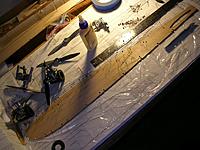Comments (3)
Add Comment
-
 Views: 54
Views: 54
Piston at TDC, piston skirt has an air gap below it. -
 Views: 53
Views: 53
Cross scavenge fence on top of the piston is facing toward exhaust port, should be on the intake port side. -
 Views: 55
Views: 55
Engine with back plate and steel fin cylinder removed. -
 Views: 56
Views: 56
New cylinder bottom gasket from a Ritz Crackers box flap. -
 Views: 58
Views: 58
Head gasket is good. K&B ensures intake side of the chamber before the piston fence is fully evacuated to combustion side with the dimple on the left. Combustion chamber is wedge shaped. -
 Views: 62
Views: 62
Engine reassembled. Exterior just needs a light going over with solvent and a brush. Engine shows hardly any sign of use.
-
 Views: 255
Views: 255
Results of a low altitude Figure-9 a decade and a half ago. -
 Views: 232
Views: 232
Close up of damage to fuselage. Engine and battery compartment were completely destroyed. -
 Views: 234
Views: 234
Patterns from scanned portion of plans for new fuselage bulkheads, cowling and sides. -
 Views: 239
Views: 239
Damaged wood is removed back far enough to make room for new wood. -
 Views: 236
Views: 236
To splice fuselage sides, a 3/32" balsa backer is needed to support the splice. -
 Views: 239
Views: 239
Right side is now in place. -
 Views: 237
Views: 237
Old cabine strut horizontal wing mount is gone. A new is fabricated out of hardwood. -
 Views: 228
Views: 228
Left fuselage side and engine mount bulkhead is now in place.
-
 Views: 334
Views: 334
Previously repaired and 3/32" balsa sides were buckled. Owner had bridged the light ply breaks with 1/8" ply. eliminating this lightening hole would allow landing forces to be transferred to the aft bulkhead. -
 Views: 343
Views: 343
3/32" aircraft grade plywood is installed as a shear panel for the landing gear block. -
 Views: 346
Views: 346
With the ply shear panel in place, balsa is used as filler for installing the 3/32" balsa side repair panel. -
 Views: 343
Views: 343
Planking complete, 3/32" bass wood sheet is used for the fuselage bottom forward of the landing gear block. -
 Views: 340
Views: 340
Firewall hole was cut for a tank without an extended edge lip on the filler cap. Hole was enlarged so tank cap now fits as in the instruction manual photo. I will seal around the cap later to keep fuel from entering the tank compartment. -
 Views: 350
Views: 350
Here, the fuselage split because of the sharp transition created by the notch for recessing the stabilizer flush. I replaced the balsa notch plate with 1/8" light ply, to reduce the loads on the balsa sides created by the notch. -
 Views: 318
Views: 318
Left was worse for wear, replaced balsa in the stabilizer notch area. -
 Views: 322
Views: 322
Right, I scraped off the previous Epoxy repair, CA'd the siding break, and used spackling compound to fill gouges caused by the Epoxy removal.
-
 Views: 345
Views: 345
Testors McCoy .40 Series 21 Black Head with YS muffler. -
 Views: 314
Views: 314
Back side of the same showing clamping system. -
 Views: 354
Views: 354
Enya .19-VI TV with new prop nut and improvised drive washer from a fender washer. -
 Views: 340
Views: 340
Restrictive baffling system and exhaust flange. -
 Views: 310
Views: 310
Baffling machined away. Still ran hot. Cap is for further modifications. -
 Views: 311
Views: 311
Testors .19 Red Head with Calumet muffler converted to tongue. -
 Views: 301
Views: 301
Enya .09-III TV with the other Calumet Muffler -
 Views: 333
Views: 333
Enya .19-VI TV with Tatone .29-.40 Peace Pipe muffler



































 ...
...


